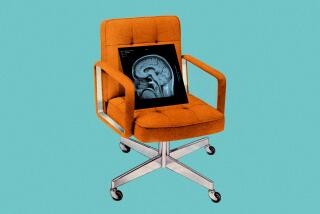Multibillion-dollar map of human brain might not be worth it
- Share via
The Obama administration is reportedly considering funding a multibillion-dollar effort to map the human brain. This so-called Brain Activity Map project is inspired by the success of the Human Genome Project in mapping the genetic code. The proposal was outlined in the journal Neuron last summer by a group of leading researchers, among them geneticist George Church of Harvard Medical School, one of the originators of the genome project. This is an endeavor with exciting potential, but we should think about the pros and the cons before proceeding.
The 10-year project’s main goals involve basic science: to learn more about perception, thinking and consciousness by recording “the patterns and sequences of neuronal firing” by every neuron in entire circuits and brain regions. These maps would not be static pictures of the anatomy of the brain. They would instead be like time-lapse photographs of cities that show how traffic pulsates and buildings light up and go dark as people move from place to place. In a brain activity map, the traffic and lights would be electrical and chemical signals, and the buildings and streets would be neurons and their connecting fibers.
This kind of data set would have much better resolution, in both space and time, and would be many, many times larger than any currently available. The project would start with small circuits in tiny organisms, where it may soon become possible to record from every neuron at once. A fruit fly brain might be done in 10 years; the cerebral cortex of a mouse in 15. As the Neuron article makes clear, mapping an entire human brain would be a more distant goal.
There are many things to like about this idea. Although we have lots of data on the brain, none of it approaches the detail level of a neuron-by-neuron map. The main source of our knowledge about how neurons work is the single-cell recording, a technique developed more than 50 years ago. Recording entire circuits in action — in the brain of a living organism — would truly be a landmark technical and scientific achievement. But there are reasons to ask whether this project is being oversold, and whether it will really solve neuroscience’s most pressing problems.
Some Brain Activity Map advocates hope it will lead to improved treatments for mental illnesses and brain disorders. Others suggest that it will yield advances in artificial intelligence. These outcomes may occur, but they may not. We deceive ourselves when we act as though the solutions to hard problems, such as curing autism or Alzheimer’s disease, or building full-scale thinking machines, can be brought about simply by investing enough money. Discovery doesn’t have that kind of input-output function, and selling it as though it does is misleading.
One reason for suspicion of the potential return on investment is that the brain project is being marketed by comparing it to the genome project, which Obama claimed produced $140 in economic activity for every $1 the government spent on it. Can a return of 14,000% (almost $800 billion from $5.6 billion) be right? The certainty with which estimates like this are presented distracts us from alternative possibilities. For example, what if the same amount of money had been spent on other genetics projects, other biology research or other science entirely? At a minimum, the $800 billion value must rest on a lot of untested and optimistic assumptions. The genome project was a great idea and a scientific success, and its results need not be inflated.
But suppose the $140 return is real. When someone tells you he bought Apple stock for $5 and sold it at $700, you should infer luck before clairvoyance, and you shouldn’t expect his next pick to be as good. For example, consider the costly but ultimately abandoned breeder reactor and superconducting supercollider projects of the 1980s and ‘90s. An analysis that looks at all the comparable projects rather than just the positive outliers might come to a different estimate of the value of the brain mapping plan.
We should also consider the opportunity cost. If the proposed project gets its billions, other neuroscience and behavioral science research will probably lose funding. Moreover, a single mega-project is likely to supplant many smaller ones. Is our neuroscience money best spent on one project costing $5 billion or 1,000 projects of $5 million each, or 20,000 $250,000 projects? It is hardly obvious which funding strategy will result in more important discoveries.
The European Union has chosen the single mega-project approach with its $1.3-billion plan to build a computer simulation of an entire brain. The United States could consider a different strategy by letting a thousand flowers bloom rather than planting one ginormous tree.
Four decades ago, neuroscientist Horace Barlow argued that the information we would get from recording the connections and activity of neurons would suffice for a “functional understanding” of the nervous system. But as others pointed out, many other levels of explanation are just as important as mapping out the brain’s component elements: understanding how the brain represents information, the algorithms it uses to process information and the way it is designed by evolution to solve certain problems with ease but other problems only with great difficulty.
The Brain Activity Map’s results would be fascinating, and might help us crack the mystery of how higher-level entities emerge from agglomerations of lower-level events — for example, how the wonder of conscious experience can be caused by the mere firing of neurons. But this project is not the be-all and end-all of neuroscience, it should not distract the field from devoting energy to other levels of analysis. Without knowing more about function, it will be hard to get the most from activity maps.
As the Obama administration’s plan moves forward, the decision-makers should keep in mind that maps, while incredibly useful tools, don’t answer all the important questions.
Christopher Chabris is a psychology professor at Union College in New York and the coauthor of “The Invisible Gorilla: How Our Intuitions Deceive Us.”
More to Read
A cure for the common opinion
Get thought-provoking perspectives with our weekly newsletter.
You may occasionally receive promotional content from the Los Angeles Times.






